There is an assortment of insulation materials for the industrial insulator. Many of these we have covered before in previous blogs or discussions. Two insulation materials often considered for high-temperature, thermal applications are Tempmat and Ceramic Fiber Blanket.
Each has unique advantages and disadvantages. One key similarity is that both physically appear white and are manufactured from similar processes using ceramic fibers. It can be confusing trying to decide which to choose for a project. Below you will find a breakdown of both products to help you understand the difference between the two and when to select one over the other.
Tempmat is non-corrosive, non-combustible, non-alkaline and chemically stable. It offers excellent heat resistance, flexibility, and low thermal conductivity which make Tempmat an effective, low-cost replacement for asbestos mats, millboard refractory paper, and other similar products. It has a temperature range for applications up to 1,200°F.
The material is manufactured entirely of long textile glass fibers, Tempmat is used in the creation of removable insulation blanket. The product assures insulation efficiency during extended exposure of elevated temperatures. However, the limiting factor to this material is that it can only be produced in one inch thicknesses and the roll widths of 60 inches can be inconvenient to work with.
Features:
- Low thermal conductivity
- Non-Toxic
- Conforms to irregular surfaces

- Non-combustible
- Excellent vibration resistance
- Superior sound absorption properties
- Will not contribute to metal corrosion
- Water and moisture resistant
Typical Applications:
- Removable pads
- Ship turbines
- Piping
- Muffler insulation
- Power generating equipment
- Industrial ovens
Ceramic Fiber Blanket is often considered for high-temperature refractory applications, and it does offer significant benefits to the industrial insulator. Manufactured along similar lines of Tempmat. Ceramic fiber is composed of long, flexible, interwoven fibers yielding a strong, lightweight, yet durable, blanket for applications in a temperature range from 1,000°F to 2,696°F.
It has the heat resistance of a hard refractory which gives it outstanding insulation value and is an effective solution for a variety of heat processing applications. The material is easy to install, requires no curing or dry out time. Rapid heat up can be achieved with all ceramic fiber blankets. The fiber blanket will not crack or spall and is thermal shock resistant. This product saves energy, reduces heat loss, and heat storage versus other hard refractory products. One of the best advantages is that it can be manufactured up to two inches in thickness. The roll size of two and four feet width is another feature that benefits industrial insulators.
Features:
- Low thermal Conductivity
- Low heat storage

- High tensile strength
- Thermal shock resistance
- Sound absorption
- Easy to install
- Contains no binder
- Contains no asbestos
Typical Applications:
- Refining and petrochemical
- Reformer and pyrolysis furnaces
- Tube seals, gaskets, and expansion joints
- High-temperature pipe, duct, and turbine insulation
- Crude oil heater linings


